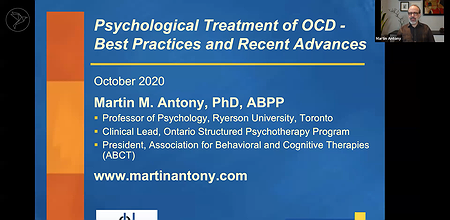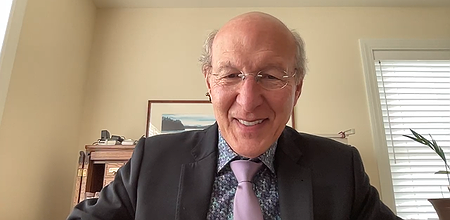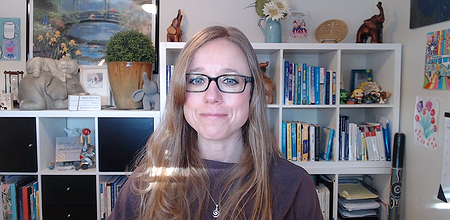- Understand the challenges in identifying and diagnosing anxiety disorders in autistic individuals
- Identify predisposing conditions inherent in autism that increase an individual’s risk of developing anxiety
- Differentiate between typical and atypical presentations of anxiety in ASD
- Modify and develop interventions to treat various presentations of anxiety in autistic clients
Treating Anxiety in Autistic Children and Adolescents
Dr. Meghan Barlow, Pediatric Psychologist
Adapt anxiety treatment to the needs of the autism spectrum disorder
Excerpt:
- 4h30 of continuing education
- 28 lessons that last from 5 to 15 minutes each
- 1 certificate of achievement
- 1 PowerPoint
- 1 bibliography
- 1 course evaluation
- 7-day money back guarantee
- Unlimited access
- 87% of participants who completed the satisfaction survey declare they would recommend this course to a colleague
Overview
Many anxiety symptoms are closely related to the core characteristics of autism. Individuals on the autism spectrum often struggle to anticipate how others will respond due to difficulties understanding social norms, further complicated by their unique sensory experience. In fact, anxiety is so frequently comorbid with autism that experts debate whether it should be regarded as one of autism’s core symptoms.
This workshop—led by Dr. Barlow, an expert in autism treatment—will guide you in adapting anxiety interventions for individuals on the autism spectrum. You will learn to recognize both typical and atypical presentations of anxiety in autistic clients, as well as how the core symptoms of ASD can predispose individuals to anxiety. In addition, you will discover how to modify empirically supported treatments to better suit the needs of this population. Topics covered include specific strategies and case examples for treating generalized anxiety, social phobia, specific phobias, selective mutism, OCD, and body-focused repetitive behaviors.
Dr Barlow will also cover approaches to address distress and anxiety arising from sensory experiences, social settings, and disruptions in routines, along with interventions for challenges such as picky eating, stimming, and pathological demand avoidance.
About the expert

Dr. Meghan Barlow, Ph.D., is a pediatric psychologist in private practice specializing in the assessment and treatment of children with autism spectrum disorder, anxiety, attention deficit disorders, and chronic medical problems. She earned her Ph.D. from Kent State University in Clinical Psychology and completed a post-doctoral fellowship at the Cleveland Clinic.
After several years on staff at the Cleveland Clinic, Dr. Barlow opened a private practice where she uses a cognitive behavioral approach to therapy and a variety of evidence based therapeutic interventions in treatment. She provides trainings to professionals and frequently presents to parent and community groups about topics in child and adolescent mental health.
Learning objectives
Learning material
A theoretical course illustrated with clinical examples. This course is composed of videos of 5 to 15 minutes each. The PowerPoint of the course to download.
Syllabus
- PowerPoint
- 1. Introduction
-
Anxiety in Autism: Patterns, Causes, and Case Insights
- 2. Autism and Anxiety
- 3. Conceptualizing Anxiety in ASD
- 4. Typical Presentations of Anxiety in ASD
- 5. Atypical Presentations of Anxiety in ASD
- 6. ASD as Predisposing Condition for Anxiety Part 1
- 7. ASD as Predisposing Condition for Anxiety Part 2
- 8. ASD as Predisposing Condition for Anxiety Part 3
- 9. What's the Point
- 10. Case Example Stephen
- 11. Typical or Atypical Presentation
-
Treating Typical and “Ish” Presentations
- 12. Adjusting and Modifying for ASD
- 13. Treating GAD
- 14. Sorting Worries
- 15. ANTs and Parent-Educator Guidance
- 16. Social Phobia
- 17. Case Example Heather
- 18. Specific Phobia
- 19. OCD
- 20. Body Focused Repetitive Behaviors
-
Treating Anxiety Secondary to ASD features
- 21. General Considerations
- 22. Sensory Sensitivities and Picky Eating
- 23. Distress-Worries Related to Interests
- 24. Social Situations, Crowds
- 25. Stimming and Repetitive Behaviors
- 26. Distress Due to Rigidity
- 27. Pathological Demand Avoidance
- 28. Conclusion
- Bibliography
CE Credits
Download a certificate of successful completion.
Audience
This course is intended for mental health professionals.
Your comments
"Thank you! I love Dr. Barlow’s creativity. Great energy and dedication!"
A psychologist (Canada)
Registration
Ask a question
Do you have a question? Then email us at contact@asadis.net
Frequently asked questions
-
Is there an evaluation at the end of the course?
To validate the achievement of the learning objectives, a final evaluation in the form of true/false questions is required. It must be completed in order to obtain the certificate of completion.
In addition, an optional self-assessment is offered at the beginning and end of the course, allowing you to measure your progress on the targeted skills.
These evaluations are not graded and are intended primarily to support your professional reflection.
-
I have a disability. Can I receive specific support?
Yes! This training is offered as a pre-recorded video format, without subtitles. If you have a disability, we can provide an adapted alternative (technical assistance for viewing or individual supervision). For any request, please contact our disability coordinator at the following address: contact@asadis.net
-
How long do I have access to the course?
After your registration, the course is accessible anytime and from anywhere with unlimited access.
-
When does the course start?
That is entirely up to you! When you buy a course, you'll receive an access link that you can activate when you want.
-
Is there a student rate?
Yes there is! To learn more, email us at contact@asadis.net.
You may also be interested in:
Legal notice
The courses offered by ASADIS are accredited by different professional organisations. In addition, ASADIS is approved by the Canadian Psychological Association to offer continuing education for psychologists. ASADIS maintains responsibility for the program.
The CPA’s approval of an individual, group, or organization as a CE Sponsor or Provider is restricted to the activities described in the approved application or annual report form. The CPA’s approval does not extend to any other CE activity the Sponsor or Provider might offer. In granting its approval, the CPA assumes no legal or financial obligations to Sponsors, Providers, or to those individuals who might participate in a Sponsor or Provider’s CE activities or programs. Further, responsibility for the content, provision, and delivery of any CE activity approved by the CPA remains that of the CE Sponsor or Provider. The CPA disclaims all legal liability associated with the content, provision, and delivery of the approved CE activity.





